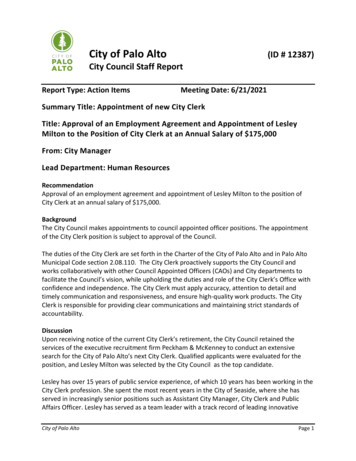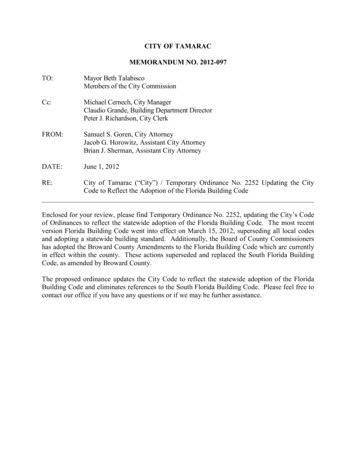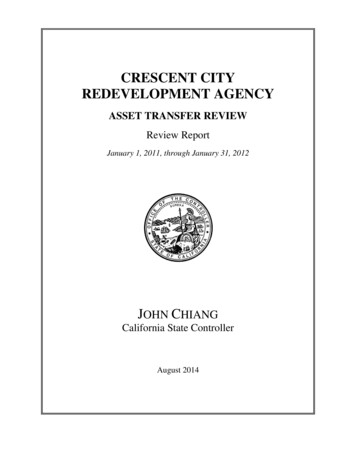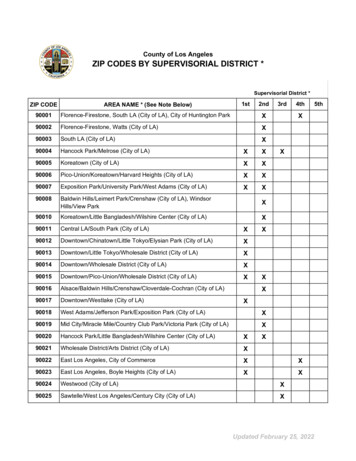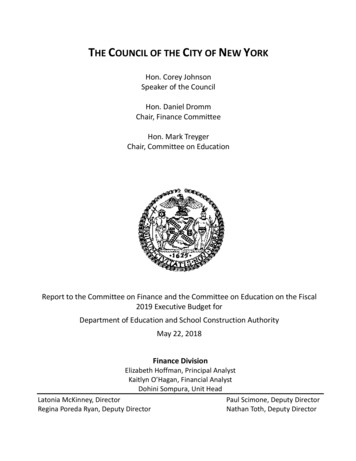
Transcription
THE COUNCIL OF THE CITY OF NEW YORKHon. Corey JohnsonSpeaker of the CouncilHon. Daniel DrommChair, Finance CommitteeHon. Mark TreygerChair, Committee on EducationReport to the Committee on Finance and the Committee on Education on the Fiscal2019 Executive Budget forDepartment of Education and School Construction AuthorityMay 22, 2018Finance DivisionElizabeth Hoffman, Principal AnalystKaitlyn O’Hagan, Financial AnalystDohini Sompura, Unit HeadLatonia McKinney, DirectorPaul Scimone, Deputy DirectorRegina Poreda Ryan, Deputy DirectorNathan Toth, Deputy Director
Finance Division Briefing PaperDepartment of EducationDepartment of Education Executive Budget OverviewDOE Fiscal 2019 Executive Budget: 25.5 billionEarly Childhood EducationPre-KDollars in Millions29% of theCity’s budget 226 878Non-Public School Payments 1,669Categorical Programs 1,716Charter Schools 2,093Special Education 3,488Fringe 3,506Support Services & Central Admin 4,414General Education6,404 Contracts totaling 7.16 billion 7,543146,748 FT/FTE headcount: 121,577 pedagogical and 25,171 civilianCouncil’s 2019 Budget ResponsePartially Included: Direct Education Dollars to Schools: 125 millionSupport Students in Shelter: 11.9 milliono Anti-Bias Training - 23.4 million over Fiscal 20192022, including 4.8 million in Fiscal 2019;Pay parity for early childhood educatorsImplement Planning to Learn recommendationsImprove Five-Year Capital Plan transparencyFund accessibility and security camera projectso Civics for All - 3.9 million in Fiscal 2019 increasingto 5.4 million by Fiscal 2022;o Health Ed Works - 2.5 million in Fiscal 2019,increasing to 7.5 million in Fiscal 2022;Major Agency Issues Accurately Project State Funding. DOE typicallyover-projects State funding and should alignfuture projections with actual funding received. Support Students in Shelter. Although theExecutive Plan provides 11.9 million in fundingfor Fiscal 2019—an increase of 1.6 million—thisfunding is not baselined. Custodial Operations and NYCSSS. The budgetfor school facilities and schools’ custodialbudgets lack transparency. Over 57 percent ofthe budget for school facilities is for the contractwith NYC School Support Services (NYCSSS), thenonprofit that supplies custodial staff to schools.Pupil Transportation. DOE is in the process ofrebidding some of their school bus contracts; itis unclear how that will affect the overall costs ofpupil transportation, and the cost of busingstudents in shelter is unknown.Executive Budget ChangesNew Needs total 191 million in Fiscal 2019. Significantnew needs include:o Universal Literacy Enhancements - 30.5 millionin Fiscal 2019 and in the outyears;Not included: 1,800 schools1.1 million studentso Air Conditioners - 10.8 million over Fiscal 20192022, including 1.7 million in Fiscal 2019;o Expansion of the Office of Equal Opportunity 1.4 million in Fiscal 2019 and approximately 1.2million in the outyears;o Carter Cases - 80 million in Fiscal 2018; ando Transportation: 20 million in Fiscal 2018. Other Adjustments increase the Department ofEducation’s budget by 525 million in Fiscal 2018 anddecrease the budget by 253 million in Fiscal 2019. Savings total 41.9 million in Fiscal 2019 due toadditional school food revenue, prior year paymentsfor special education, and a baselining of 20 million inOTPS surplus from school budgets. The Capital Commitment Plan includes 125 millionadditional capital funding for AC-related projects.1
Finance Division Briefing PaperDepartment of EducationDepartment of Education IntroductionThis report presents a review of the Department of Education’s Fiscal 2019 Executive Budget. Thesection below presents an overview of the Department’s budget and how it has changed duringthe course of Fiscal 2018, followed by a review of the significant budget actions introduced in theFiscal 2019 Executive Budget. Major issues related to the Department’s budget are thendiscussed. Analysis and highlights of the Department of Education’s Capital Program follows thediscussion of the expense budget. Appendix 1 reports the changes made to the Fiscal 2018 andFiscal 2019 Budgets since Adoption of the Fiscal 2018 Budget. For additional information on theDepartment’s budget and its various programs, please refer to the Fiscal 2019 Preliminary BudgetReport for the Department of Education at: se.pdf.Below is a summary of the Department’s financial plan by Unit of Appropriation when comparingDOE’s Fiscal 2019 Executive Budget to its Fiscal 2018 Adopted Budget.Department of Education Financial Plan SummaryDollars in ThousandsPersonal ServicesOther Than Personal ServicesBudget by Unit of Appropriation401 - GE Instr. & Sch Ldrshp - PS402 - GE Instr. & Sch Ldrshp - OTPS403 - SE Instr. & Sch Ldrshp - PS404 - SE Instr. & Sch Ldrshp - OTPS406 - Charter Schools407 - Universal Pre-K - PS408 - Universal Pre-K OTPS409 - Early childhood Programs - PS410 - Early childhood Programs - OTPS415 - School Support Orgs. - PS416 - School Support Orgs. - OTPS421 - Citywide SE Instr. & Sch Ldrshp - PS422 - Citywide SE Instr. & Sch Ldrshp - OTPS423 - SE Instructional Support - PS424 - SE Instructional Support - OTPS435 - School Facilities - PS436 - School Facilities - OTPS438 - Pupil Transportation - OTPS439 - School Food Services - PS440 - School Food Services - OTPS442 - School Safety - OTPS444 - Energy & Leases - OTPS453 - Central Administration - PS454 - Central Administration - OTPS461 - Fringe Benefits - PS470 - SE Pre-K Contracts - OTPS472 - Contract/Carters/Foster Care - OTPS474 - Non-Public and FIT - OTPS481 - Categorical Programs - PS482 - Categorical Programs - OTPSTOTALActual2016 14,470,3777,951,183Actual2017 14,565,1858,942,853Adopted2018 15,189,6039,139,253Executive Plan20182019 15,562,711 15,901,6439,461,7299,632,030 0,614 22,421,560 4,552 23,508,039 1,083,602604,442 24,328,855 1,049,837679,243 25,024,440*The difference of Fiscal 2018 Adopted compared to Fiscal 2019 Executive Budget.2 511,054,026661,865 25,533,6732018 - 2019*Difference 712,040492,777 6525,000(390)(29,576)57,423 1,204,818
Finance Division Briefing PaperDepartment of EducationSignificant Programmatic Changes General Education and School Leadership. As outlined in the Financial Plan Summary, thelargest change in DOE’s budget is in U/A 401, General Instruction and School LeadershipPersonal Services (PS). Funding increased by 301 million or five percent when compared tothe Fiscal 2018 Adopted Budget for a total of 6.7 billion in the Fiscal 2019 Executive Budget.The year-over-year increase in this U/A is largely due to previously scheduled increases forschool budgets, including increases for Equity and Excellence programs and collectivebargaining payments. Changes introduced in the Executive Budget add 93 million to U/A401. In total, 260 million of growth from Fiscal 2018 to Fiscal 2019 was accounted for in the2018 Adopted Budget. The remaining increase of 41 million since adoption in U/A 401 alsoincludes 1 million for Civics for All, 5 million for students in shelter, 2 million for anti-biastraining, 86 million for Fair Student Funding, and 1 million for Universal Literacy. Thisspending is offset by 54 million in savings for a total of 6.7 billion to support GeneralInstruction and School Leadership. Special Education and School Leadership. When compared to the Fiscal 2018 AdoptedBudget, Special Education and School Leadership is expected to increase by 85.3 million, orfive percent. Of that amount, 12.8 million is related to the increase in Fair Student Funding.Increases in this U/A are expected as the number of students enrolled in special educationhas been steadily increasing from 239,619 in Fiscal 2015 to 260,482 in Fiscal 2017. Charter Schools. Funding for charter schools is projected to total over 2 billion, a 145.8million or seven percent increase when compared to last year. Charter school spendingcomprises 7.8 percent of DOE’s budget. Charter school costs continue to rise annually due toState mandates, increases in the number of charter schools, and increases in charter schoolenrollment. For example, in Fiscal 2017 DOE reported 119,622 students and 220 charterschools, which grew to 131,142 students and 231 schools this fiscal year; an increase of11,520 students and 11 charter schools in one year. It is expected both charter schoolenrollment and the number of charter schools will grow in Fiscal 2019. The State mandatesthat DOE pay a per-pupil tuition rate for each student enrolled in a charter school and thecurrent rate, set by the State, is 14,527. DOE is also required to pay for charter facilitiesrental aid in privately leased space if the charter school is not located within a DOE building.DOE is making 44.9 million in rental assistance payments to charter schools in Fiscal 2018. Early Childhood Programs. The Fiscal 2019 Executive Budget reflects the transfer ofEarlyLearn contracts from the Administration for Children’s Services (ACS) to DOE. Thischange was accounted for in the Fiscal 2018 Financial Plan Preliminary Budget with anincrease of 507 million in Early Childhood Programs OTPS. The Executive Budget reflects asmaller transfer of 210 million to support EarlyLearn. This is due to the fact that the contractswill remain at ACS for the beginning of the next fiscal year. DOE prorated funding for sevenmonths to ACS to administer the contracts until the planned transfer on February 1, 2019.DOE anticipates releasing an RFP for childcare services in early 2019 to begin programming inthe Fall of 2020.3
Finance Division Briefing Paper Department of EducationFringe Benefits. Fringe benefits are projected to increase by 250 million when compared tothe Fiscal 2018 Adopted Budget. However, most of this increase was accounted for in thePreliminary Budget, with only a 23,071 increase included in the Executive Budget. Theincrease in fringe benefits is a result of actions in previous plans including collectivebargaining and increases in headcount for programs such as AP for All, Universal Literacy, andphysical education teachers.Department of Education OverviewThe Department of Education’s (DOE or the Department) Fiscal 2019 Budget totals 25.5 billion, 1.2 billion more than the Fiscal 2018 Adopted Budget of 24.3 billion. The personal services (PS)budget totals 15.9 billion and other than personal services (OTPS) totals 9.1 billion.In addition to the DOE’s budget, total City spending related to education includes pension anddebt service costs. Total pension costs for Fiscal 2019 are projected to be 3.9 billion and totaldebt service is 2.8 billion for total Fiscal 2019 educated related spending of 32.2 billion. Pensionand debt service costs are not included in DOE’s budget.Funding SummaryDollars in ThousandsCityStateFoundation AidFormula AidBuilding AidCategorical ProgramsSpecial Education Pre-KState Food ProgramsRevenue in Other AgenciesSubtotal StateFederal - OtherTitle ITitle IIAIDEAMedicaidSchool LunchBreakfast ProgramEducation for Homeless Children and YouthOtherSubtotal FederalFederal - CDIntra-cityOther CategoricalSubtotalTOTAL DOE FUNDING Adopted2018 11,648,572Executive Plan20182019 12,189,133 12,303,571*Difference2018 - 2019 654,999 0) 10,680,244 0) 10,756,545 0) 11,105,503 306,8539,9768,44212,82087,16800 425,259 859 1,788,700 28,20012,188170,952 211,340 24,328,855 859 1,825,350 31,69054,972166,749 253,411 25,024,440 526 1,944,397 5,73410,010164,456 180,200 25,533,673 0018,000038,0003,38065095,667 155,697( 22,466)(2,178)(6,496)( 31,140) 1,204,818City Funds. The DOE’s Fiscal 2019 City-funded portion of the budget shows an increase of 655 million when compared to the Fiscal 2018 Adopted Budget, for a total of 12.3billion, or 48 percent, in City funding in the Executive Budget.4
Finance Division Briefing PaperDepartment of Educationo State Aid Backfill. The Fiscal 2019 Executive Budget includes 135 million toaccount for lower than projected State revenue. Although DOE did receive a 3.27percent increase in State aid when compared to last year, it was lower than the4.3 percent increase DOE projected. The Executive Budget accounts for thisshortfall by providing 135 million in City funds. This is categorized as State Aidbackfill but there is not a commensurate reduction in State aid included in thefinancial plan. State Funds. The DOE’s Fiscal 2019 Executive Budget shows a 425.3 million increase inState funds when compared to the Fiscal 2018 Adopted Budget. This increase is mostlycomprised of an increase of 306.8 million in Foundation Aid. The remainder of theincrease includes 87.2 million in State support for Special Education Pre-K, 12.8 millionin Categorical Programs, 10 million in Formula Aid, and 8.4 million in Building Aid. Intotal, 11.1 billion, or 43 percent, of DOE’s budget is supported with State funds. Asignificant portion of State funding supports mandated programs such as charter schoolsand special education. Federal Funds. Federal support remains fairly consistent year-over-year with a 155million increase in Fiscal 2019 when compared to the 2018 Adopted Budget. One majorchange in federal funding in Fiscal 2019 is the increase in revenue to support universalfree lunch. Prior to the start of this school year, DOE identified over 195,000 additionalstudents as eligible for free lunch through the direct certification process and this allowedthe City to surpass the 40 percent threshold required for universal participation in afederal school food program, the Community Eligibility Program (CEP). This allows DOE tocollect the highest rate of reimbursement, 3.37, for each lunch ed2018Executive Plan20182019PositionsFull-Time Non-Pedagogical12,24812,52811,41012,271Full-Time 7131,199131,799131,884*The difference of Fiscal 2018 Adopted Budget compared to Fiscal 2019 Executive Budget. 12,358120,720133,078*Difference2018 - 20199483311,279The Executive Budget supports 133,078 full-time and 13,670 full-time equivalent (FTE)positions for a total headcount of 146,748 positions. Pedagogical employees comprise120,720 of the full-time positions and 857 of the FTEs. Non-pedagogical employeescomprise 12,358 of the full-time employees and 12,813 of the FTEs. Total headcount hasincreased by 1,279 positions when compared to the Fiscal 2018 Adopted Budget.New in the Executive BudgetThe Department of Education’s Fiscal 2019 Executive Budget introduces 191 million in newneeds, including approximately 137 million for initiatives the Council called for in the Fiscal 2019Preliminary Budget Response.5
Finance Division Briefing PaperDepartment of Education Fair Student Funding. In the Budget Response, the Council called on the Administration toallocate more funding directly to schools through Fair Student Funding (FSF) and it has beenincluded in this plan. The Fiscal 2019 Executive Budget commits 125 million in City fundsand grows to 132 million in Fiscal 2022 to maintain a 90 percent FSF floor for schools. Nextschool year, over 850 schools will see an increase and the FSF floor will be raised from 87 to90 percent. The system-wide average will increase from 91 to 92.7 percent. Students in Shelters. The Students in Shelter program is designed to better support the needsof homeless students by providing additional supports in schools with the highestconcentrations of students living in shelters. This program, funded in Fiscal 2017 and 2018 at 10.3 million, provides literacy support through after-school tutoring in shelters, socialworkers in schools, admissions support in shelters, and health and mental health services inschools. The Executive Budget includes funding in Fiscal 2019, again for only one year,totaling 11.9 million. The additional funding will provide for 10 additional Bridging the Gapsocial workers to serve 10 additional schools with high concentrations of students intemporary housing (STH). This will bring the total number of schools with a dedicated Bridgingthe Gap social worker to 53. Additionally, two content experts will be hired as supervisors.Funding to increase the after-school literacy program in shelters is funded through anexpansion of Universal Literacy described in more detail below. There is no change to thehealth and mental health component to this program for the next school year, which iscurrently in 62 schools and 10 campuses. Universal Literacy Enhancements. First funded in Fiscal 2017, the Fiscal 2019 ExecutiveBudget includes baseline funding for an additional 30.5 million for the Universal Literacyinitiative. This program aims to ensure every student is reading at grade level by the end of2nd grade by providing support from a literacy coach. An associated headcount increase of 31positions includes 25 reading coaches to work in 25 of the lowest performing schools, as wellas six supervisors. Funding will also be used to expand literacy after-school programs inshelters. The after-school program is currently operating in 18 shelters and will expand to anadditional 20 shelters for a total of 38 shelters next school year. Additionally, UniversalLiteracy will provide training for special education teachers working with English LanguageLearners and principals, and create a web platform where parents can track student progress.Total headcount for Universal Literacy is expected to reach 498 positions, including 14 literacycoach supervisors. Air Conditioners. In the Fiscal 2018 Budget Response, the Council called on theAdministration to provide air conditioning (AC) in all classrooms. The Fiscal 2018 ExecutiveBudget included funding for window AC units totaling 28.75 million from Fiscal 2018-2022to install ACs in approximately 11,500 classrooms (window AC units are not capital-eligible).DOE conducted a survey of classrooms this year and discovered that an additional 5,200classrooms are without AC or a working AC. As a result, the Fiscal 2019 Executive Budgetprovides 10.8 million over Fiscal 2019-2022 for the installation of ACs in these additionalclassrooms, including 1.7 million in Fiscal 2019. This brings the total expense fundinginvested in this initiative to almost 40 million over the financial plan. The Executive CapitalBudget also invests 125 million for electrical upgrades related to AC, discussed on page 12. Anti-Bias Training. In the Fiscal 2019 Executive Budget, DOE is funding anti-bias training forall DOE staff, including staff in schools, field offices, and central offices. In order to provide6
Finance Division Briefing PaperDepartment of Educationthis training, 4.7 million is included in Fiscal 2019, increasing to 6.9 million in Fiscal 2022 inorder to reach all staff over four years. Training is intended to raise awareness about implicitbias and improve race consciousness. DOE plans to use outside trainers and has included 2.9million in OTPS funding for Fiscal 2019. The estimated cost of per session to cover staff time,including fringe, is 1.8 million in Fiscal 2019 and totals approximately 10.9 million acrossFiscal 2019-2022. Carter Cases. The Fiscal 2019 Executive Budget includes 80 million in City funds to theincreased cost of Carter Cases in Fiscal 2018. The number of claims paid to families for settledcases increased from 6,700 in Fiscal 2014 to 11,000 in Fiscal 2017. This is partly due to a policychange made by this Administration to challenge cases less aggressively, as well as decidingwithin 10 days to proceed with a hearing or settle a case. While there is an increase in casesand spending, this funding has not been baselined. Carter Case payments can includeprevious years since it can take several years to settle a case. There is no guarantee that aspecific Carter Case payment will continue in future years. Federal law requires DOE toevaluate the status of the student annually; only once the student has been evaluated doesDOE continue paying for the child’s educational setting. Civics for All. As announced in the Mayor’s 2018 State of the City address, the Fiscal 2019Executive Budget commits funding to provide civic education in schools. The plan includes 3.9 million in Fiscal 2019 growing to 5.4 million by Fiscal 2022. Funding increases in theplan in order for DOE to train additional staff. There is a headcount increase of nine positions,which includes five borough leads at each Field Support Center, two curriculum writers, andtwo managers. Of the Fiscal 2019 funding, 1.8 million is for the additional staff and 2.1million is for OTPS costs. District 1 Family Resource Center. The District 1 Family Resource Center provides familieswith counseling services, enrollment specialists, and referrals for services, including, but notlimited to, financial and immigration assistance through community-based organizations. TheFiscal 2019 Executive Budget includes baseline funding for four positions totaling 428,415at the District 1 Family Resource Center that were previously funded by a State grant. Fundingincreases slightly in the outyears to 438,715 to account for increases in fringe benefits. Expansion of the Office of Equal Opportunity. The Fiscal 2019 Executive Budget includesbaseline funding for 11 positions within the Office of Equal Opportunity by providing 1.4million in Fiscal 2019 and approximately 1.2 million in the outyears. Funding is higher in thefirst fiscal year to accommodate for increased costs associated with expanding the office.Positions added to the Office of Equal Opportunity include eight investigators, two attorneys,and one administrative aide. Health Education Works. The Fiscal 2019 Executive Budget includes 2.5 million, increasingto 7.5 million in Fiscal 2022 for Health Education Works. Additionally, the budget includesbaseline funding for five positions in Fiscal 2019 and three is Fiscal 2020 for a total headcountincrease of eight positions to implement comprehensive health education in all schools. InFiscal 2019, the positions include one director, one manager, one data analyst, and twoteacher leaders. In Fiscal 2020, one director and two teacher leaders will be added. Underthis plan, 500 teachers will become certified as health educators. Funding increases in theoutyears as DOE provides training to additional staff.7
Finance Division Briefing Paper Department of EducationNew Schools-Maintenance & Operations. In order to provide basic maintenance andoperations in new school facilities opening in 2019, the Executive Budget includes baselinefunding of 8.9 million and 10 positions. The 8.9 million is broken down as follows:o 469,000 for seven nurses;o 4.1 million for facilities costs, including a 3.3 million increase to the annual contractwith NYC School Support Services (NYCSSS) for custodial staff;o 2.5 million for school food services, including the three school food employees;o 1.1 million for heat, light, power, and fuel; ando 638,000 in fringe associated with the additional headcount. Transportation. In order to align expenses and actual spending, the Fiscal 2019 ExecutiveBudget includes 20 million for Fiscal 2018 for transportation costs. It is unclear why thisfunding is not baselined and what drove the increased spending in the current fiscal year.Other adjustments introduced for Fiscal 2019 decrease DOE’s budget by 253 million. Significantadjustments include: Collective Bargaining Lump Sum. The Fiscal 2019 Executive Budget includes 447 millionin lump sum payments to DOE employees in Fiscal 2018 as a result of a nine-yearagreement reached between the United Federation of Teachers (UFT) and the City in2014. DOE staff who retired from November 2009 to June 2014 were eligible for a lumpsum payment for two four-percent retroactive raises to the first two years of the nineyear agreement. Staff who retired after June 2014 or remained employed also receivedlump sum payments, but the payouts were spread over a five-year period. In Fiscal 2016,12.5 percent of the lump sum was paid, 12.5 percent (or 447.7 million) will be paid thisyear and is included in this budget, and 25 percent will be paid each October for the nextthree fiscal years (2019-2021). DOE’s budget does not include any money in the outyearsfor these lump sum payments.Payments are made to a range of DOE staff including teachers, principals, custodialengineers, and skilled trade workers. The adjustment in this budget includes 401 millionfor employees represented by UFT, 40 million for employees represented by the Councilof School Supervisors and Administrators (CSA), and 6 million for employeesrepresented by other collective bargaining units. Building Aid for Lead Testing. The Fiscal 2019 Executive Budget includes 9.8 million inFiscal 2018 and 8.4 million in Fiscal 2019 in State Building Aid reimbursements for leadtesting in schools. A 2016 State law provides building aid to school districts for leadtesting and effective remedial measures for such costs incurred prior to July 1, 2019. Extended Use. In order to provide fee waivers to groups requesting to use school space,in the Fiscal 2019 Preliminary Budget DOE provided 2 million in Fiscal 2018 and 2019.The Fiscal 2019 Executive Budget includes an increase in headcount for one position forthis program. There is no financial impact associated with this in the Executive Budget. Revenue Adjustment. The Fiscal 2019 Executive Budget reflects an adjustment of 79million to accurately reflect charter school revenue for the supplemental tuition rate,which is set by the State at 1,000 per student. The State did provide this funding for the8
Finance Division Briefing PaperDepartment of Educationupcoming school year in the 2018-2019 State Budget and it is now reflected in the City’sExecutive Budget. Heat, Light and Power and Heating Fuel Adjustment. The Fiscal 2019 Executive Budgetincludes 17.6 million in Fiscal 2018 and 5.1 million in Fiscal 2019 and in the outyearsfor heat, light, and power at DOE facilities. It includes adds 7.8 million in Fiscal 2019 andin the outyears for heating fuel.Savings School Food Savings. Beginning this school year, DOE began offering free universal lunchto all students through the federal Community Eligibility Provision (CEP). The Fiscal 2019Preliminary Budget reflected this change with 38 million in federal revenue to providefree lunch to all students. Prior to this change, only stand-alone middle schools haduniversal free lunch. The City had budgeted 44.3 million in City funds to support the freelunch program, including the middle school program. In the Fiscal 2019 Executive Plan,DOE replaces City funds with federal funds and recognizes a savings of 6.3 million, whichwas funding used to support the middle school program. This support for middle schoolis no longer needed since CEP allows for all lunches, including middle school, to bereimbursed at the highest federal rate. Reduction in OTPS Surplus Allocation. The Fiscal 2019 Executive Budget baselines 20million in savings by reducing the OTPS budget for general instruction and schoolleadership. Currently, schools roll approximately 40 million from year-to-year, and thiswould capture savings from 50 percent of the unspent money instead of rolling it fromFiscal 2019 to Fiscal 2020.Budget IssuesThe following section discusses issues and concerns as it pertains to DOE’s Fiscal 2019 ExecutiveBudget.Fiscal 2019 Preliminary Budget ResponseIn the Fiscal 2019 Preliminary Budget Response, the Council called for the following changes tothe expense budget, which were partially or not included as part of the Fiscal 2019 ExecutiveBudget. Direct Education Dollars to Schools. The Council called on the Administration to makeachieving 100 percent FSF in all schools the top educational priority of this budget and theAdministration responded with a 125 million increase to FSF. While this will raise the FSFfunding floor to 90 percent, the Council is still wants to ensure that all schools reach 100percent FSF within three years. This would cost 625 million using school level data from thisschool year. Schools would use additional resources to hire additional social workers,guidance counselors, teachers and other staff, as well as properly equip classrooms andsupport enrichment programs. Support Students in Shelter. The Council called upon the Administration to add 22.4 millionto DOE’s budget to fund a new FSF weight for homeless stu
Custodial Operations and NYCSSS. The budget budgets lack transparency. Over 57 percent of the budget for school facilities is for the contract with NYC School Support Services (NYCSSS), the nonprofit that supplies custodial staff to schools. Pupil Transportation. DOE is in the process of rebidding some of their school bus contracts; it





